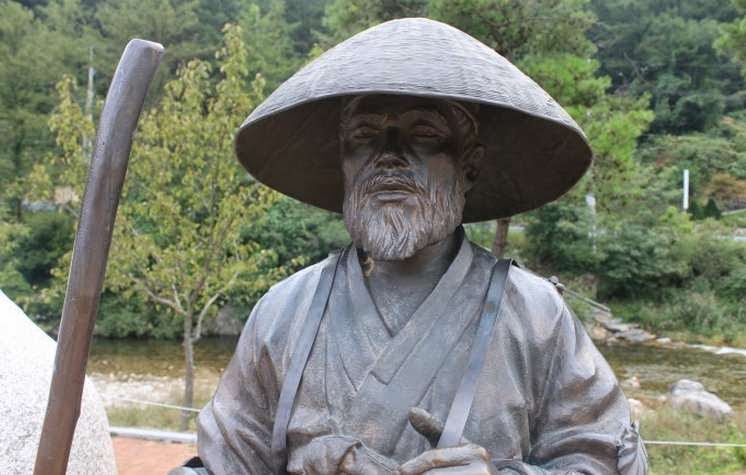Buseoksa, the jewel of Korean architecture was built by Monk Uisang during King Munmu's reign (676) of Silla Dynasty.
Teacher Jeon brought us to the courtyard in front of Muryangsujeon and stated to tell us the legends pf Buseoksa temple:
1. Monk Uisang and Lady Seonmyo
King of Silla Kingdom asked Monk Uisang (의상대사) to go to Tang Dynasty in China to study Avatamsaka Sutra (Flower Garland Sutra).
Lady Seonmyo took care of Monk Uisang during his stay in her house.
He was invited by a local Buddhist lay-family to stay in their home. His daughter, SeonMyo (선묘), fell deeply in love with UiSang. But, Uisang could not accept her love, as he was a monk, who took his precepts seriously. Seonmyo respected and understood his position, and she became his faithful disciple and made a vow of eternal devotion to him as her mentor.
Monk Uisang heard that Tang is going to invade, therefore he need to go back to Korea and report to the king about the war. As he didn't find Lady Seonmyo at home, he left without saying a word...
When Lady SeonMyo found out that Uisang was leaving,
she quickly wrapped a robe and bowl as souvenir to Uisang,
but when she rushed to the harbor, the ship left...
(Sad story! suddenly my tears rolled down my face)
Lady Seonmyo prayed to Buddha, jumped into the sea and became a dragon,
She wanted to protect and follow him on his way back to Silla...
(my tears flowed crazily and unstoppable!!!)
Because of the timely news about the invasion, Silla won the war against Tang. King Mummu asked Uisang to build as many temples as he could. He built about 10 important temples in Korea.
~Floating Stone~
However, this place belongs to Goryeo, about 500 locals stood against him and tried to kick him out from Goryeo. Lady SeonMyo turned to a big rock and flew over the 500 locals, and they were killed.
Therefore, the temple named as Buseok (부석 = floating stone).
This huge floating stone stands on the left side of Muryangsujeon. According to I Jung-Hwan's Taekriji written during King Sejong of Joseon Dynasty noted: "There is a slight gap between the two filed rocks, so puling the thread proves that the upper rock is floating above the lower rock."
Lady Seonmyo turned herself to stone dragon,
and was buried in the courtyard of Muryangsujeon.
However, the dragon was cut into half by Japanese during their occupation in Korea, as they heard that the dragon was guarding the temple.
2. Monk Uisang's cane
Famous 'Seonbihwa' tree In front of Josadang
When Priest Uisang was leaving for India, he planted his walking stick into the ground. He said that if the stick grow to be a tree, means that he's still alive. This tree is still growing and blooming flowers in every May for 1,300 years!
There's another story where the Japanese officer cut the tree and moved it to his own garden. And, he had bad luck after that, and eventually sentenced to death.
Too bad that we'd no time to see this legendary tree with our own eyes...
3. Blueprint of Buseoksa Temple
Buseoksa is an outstanding example of mountain temple, and counted as the epitome of Korean architecture.
Lady Seonmyo told Monk Uisang to fast for 7 days before building the temple. At the end of the 7 days, he envision this blueprint, Chinese character of Hwa (華).
Layout of Buseoksa Temple based on Chinese letter 'Hwa'
that embodies the belief of the Hwaom (화엄) Buddhist Sect.
Buseoksa is famous of its structural beauty, the scenery that encompasses the Anyangru Pavilion and Muryangsujeon Hall that actively engages the different ground levels provide different views on each platform achieving unification over various spaces.
There are 108 steps from Heavenly King Gate (Cheonwangmun) to Paradise Gate (Anyangmun). Strong will is needed to make to Nirwana, as visitors must climb a series of 108 stepping stones to achieve Nirvana. It represents that you need to win over earthly temptations or troubles to arrive at Anyangmun!
We're finally here... 'The Entrance to Heaven'
Can you see Boddhisatvas sitting on the Anyangru Pavilion?
Isn't it awesome?! Various methods by aligning pillars in gradually ascending height, inward-slanting of the last pillars on both sides were applied to have these optical illusions.
refreshing and beautiful scenery from Anyang courtyard...
over the mountainous landscape.
spectacular sunset scene from Anyang Pavilion
Kim Sat Gat once visited Buseoksa, sat on Anyang Pavilion
admiring the view and composed the above poem.
Teacher Jeon recited the poem in English version. I couldn't recall it, but somehow the poem described my mind at that point of time...
I shredded tears while listening to the poem ㅠㅠ
(... I'm already at my middle age, how many times more can I see this beautiful scenery...?)

Teacher Jeon also told us the background of Kim Sat Gat...
(click the link for the photo source)
His real name was Kim Byeong-yeon, but known as Kim Sat Gat (김삿갓). He was a great scholar, but he found out that his grandfather was a traitor. Therefore, Kim spent most of his life traveling and wandering around Korea for more than 30 years, wearing his Bamboo Hat (Sat Gat). The hat represented his guilty feeling and even ashamed of the sunlight.
He became famous after composed numerous poems praising the beauty of nature and humanism, but sarcastically criticizing human greed or materialistic class-conscious society. Really admired his righteous mind and adventurous spirit!
Related Posts:

.jpg)


.jpg)






.jpg)
.jpg)


